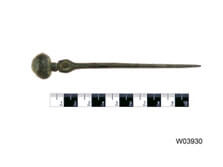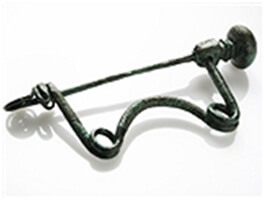In the back of a dark cupboard in the Abbey Museum storage area sit a few items of hidden treasure with signs saying DO NOT LIST. These items have been there for a very long time. Why you may ask? Well it is because their provenance is unknown or attempts in the past to identify their origins had been unsuccessful. Enter the internet revolution with its ability to access to an enormous wealth of knowledge and the games has changed. The Abbey Museum Senior Curator, Michael Strong, asked if I would take on the challenge to try to find out something about our hidden treasures. Being more than a little obsessive, I tend to like this type of challenge.
When I start researching an object that we know very little about I start by looking for pictorial comparisons. Sometimes very few comparison can be found, as with two lovely glazed ceramic tiles with fruit that i have been researching lately. However at other times luck (or skill) is on our side and exciting discoveries are made. We are pleased to say that to date we have been able to take four artefacts from our DO NOT LIST “hidden treasures” and register them into the collection. These were an early Australian ginger beer bottle from Ballarat, an English ceramic ink bottle, a French alabaster bust of the Virgin Mary and a little seemingly insignificant bronze pin.
Hidden Treasure Revealed

This little bronze pin was a most interesting find. It was obviously part of something else, as it had a small piece broken off in a hole just under the head. In old documented classifications it was thought to be part of a 1st Century AD Roman brooch pin and later a Celtic penannular brooch pin. However these titles were dismissed in the 1980s by an expert at the British Museum. So the pin remained in a little plastic bag in the back the cupboard. Now, after much searching, a similar comparison has been found and it is very exciting!
It seems our pin is an unusual one. It has a mushroom shaped head and a hole incorporated in the shaft of the pin. A photo of an artefact in the Archaeological Museum of Schiavi di Abruzzo in Italy shows how a similar pin would have been attached to a spring so that it forms an early type of safety pin. These pins are called fibulae and this one is an early serpentine examples dating from 11 – 10 century BC.

The term fibula, from Latin, is used to refer to brooches that continue Italic or Roman forms from the ancient and early medieval world. Fibulae were used not only as brooches but also as the mechanism to hold clothing together. In fact, for men, keeping the fibula fastened was the equivalent to keeping one’s pants on.
The development of fibulae seems to have begun in the Villanovan period and during this time they were found in burial urns with ashes. Their forms continued through the Etruscan period and into Roman times.
The evolution of the fibulae followed the lone straight pin, with early forms such as this one incorporating a separate pin. These were replaced by a one piece bow or leech pin like a safety pin, and eventually they were replaced by buttons. Fibulae were used by soldiers and civilians, and by men, women and children and could indicate culture, tribe, sex, status or profession.
How amazing to have discovered we have a pin from an Italic serpentine fibula from 11 – 10 century BC and to think that it languished as a hidden treasure at the back of a cupboard!
Visit us at the Abbey Museum, you will find many unexpected treasures.

